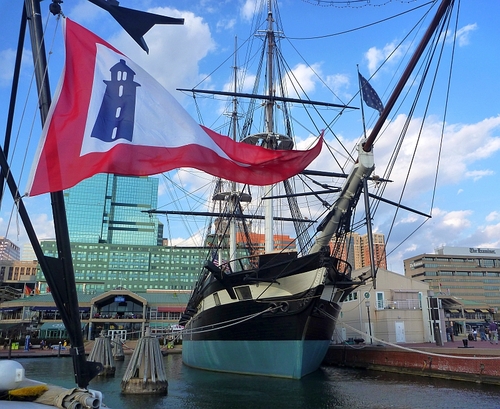
The pennant of the USLHS aboard Roper as we passed by the USS Constellation in Baltimore’s Inner Harbor.
Read along here for an account of our recent trip to Baltimore to participate in the annual conference for the Society for Historic Archaeology. The conference theme was “By The Dawn’s Early Light: Forging Identity, Securing Freedom, and Overcoming Conflict” As usual, LAMP brought all of its resources to bear and had a grand time presenting to, and learning from, other professionals in the field.
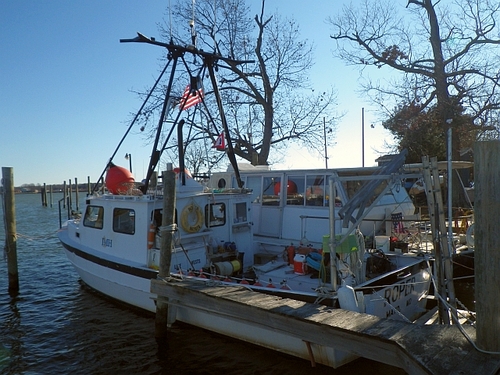
Roper at her frigid dock in Tall Timbers, MD before getting underway to Baltimore.
Halyards slapped angrily against masts, the stuttered metallic rhythm of storm winds blowing through a marina. Inside Roper’s pilothouse, Brian McNamara and I crawled through the engine room bilge for one last time, rubbing down her plating, wiping the engine, and generally cleaning the workspace. Clambering out and replacing the cabin sole, we stood by the boat’s small cast iron stove to warm our chilled fingers. A pot of hot coffee simmered on the stove, to be plundered at moments like this. The two of us were wearing overalls and smudge stains from the past day and a half of crawling through the boat to perform maintenance like oil changes and fuel filter changes, loading supplies, and making a few repairs or adjustments to the steering system and navionics. The list of things we could accomplish was growing smaller as the wind grew stronger and the temperature dropped. Listening to NOAA forecasts caused shudders in the spine as wind chills were to drop into dangerously low levels, especially for a couple of Florida boys!
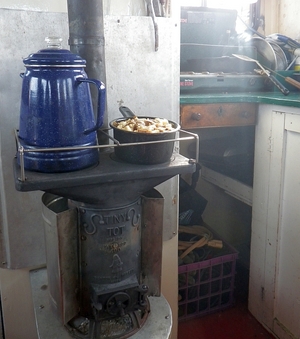
The shipboard stove, with necessities on top.
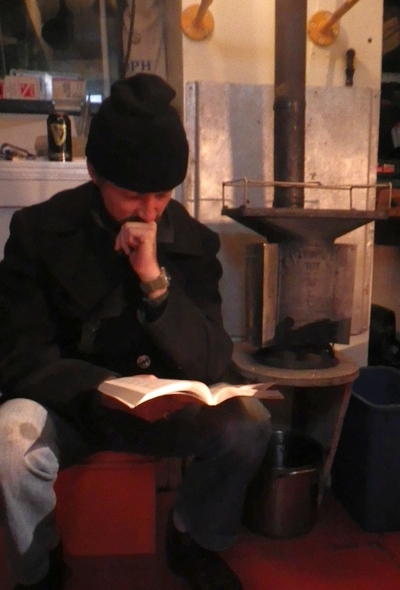
LAMP Intern Brian McNamara sits by Roper’s stove one evening trying to read and stay warm.
Brian and I, along with the rest of LAMP, has been used to Roper as a warm season boat. Ambient cabin temperatures for us usually hover in the mid nineties. With her simmering Caterpillar belowdecks and exhaust plenum sharing the wheelhouse space, most sane folks take to the deck or cabintop to prevent overcooking. This was definitely not a problem now for the two of us. Brian and I had arrived at Tall Timbers Marina, in southern Maryland, to prepare and join Roper for a charge up the Chesapeake Bay to Baltimore. The annual conference for the Society for Historic Archaeology was held this year in Baltimore. In the heart of the Clipper City, on the banks of the inner harbor, around two thousand archaeologists were to gather and confer over the past year’s work, compare notes, and present the findings from our most recent field seasons. LAMP held a session on our work at the 18th century Storm shipwreck site as well as putting together a table in the bookroom advertising our upcoming programming and displaying our publications. The coup de grace for the conference was the joint Institute of Maritime History/LAMP showing of Roper, the research vessel used during LAMP’s past three field seasons and the primary platform for IMH’s archaeological reconnaissance throughout the Chesapeake Bay and elsewhere.
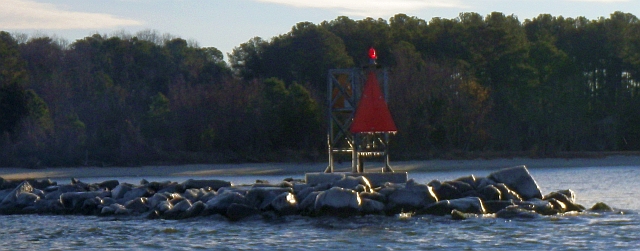
An ice encrusted jetty on the Potomac at the mouth of Herring Creek. Brrrr!
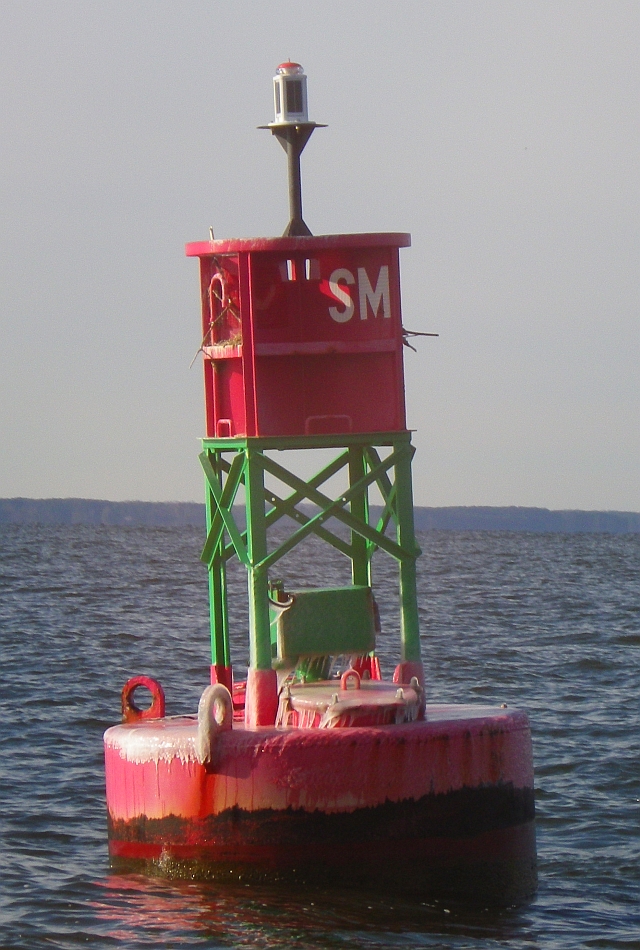
Steady steaming for just under sixteen hours will get you from Tall Timbers to Baltimore. Head out of Herring Creek into the Potomac River, follow the river down to its mouth and round Point Lookout. Then, shape a course up the bay past Cove Point, Point No Point, leave Tilghman Island to starboard, the lights of Annapolis to port, and finally follow the shipping channels up the Patapsco River into Baltimore. The morning we actuated the plan we were already eight hours behind schedule. Strong winds had whipped the bay into an uninviting froth that would punish us and equipment unduly. Finally, in the pre-dawn hours of January 4th, the winds abated and waters calmed. The high pressure system bringing the winds also brought bitter cold. At 0700 I lit a fire in Roper’s cabin stove and singled up lines to depart. When I hit the starter button to bring the engine up to temperature, the Caterpillar growled over a couple cranks and guttered to life. Even the stalwart diesel was shuddering from the temperatures but quickly gained stride and evened out her tone. Topped off with fuel, and fresh engine oil and fuel filters, we slipped lines and departed for SHA. I motored Roper out of her slip and went to make the turn to round #6 mark and stand out to the river but there was no response from the helm. A quick diagnosis found that the cold steering fluid needed more air pressure from the reserve tank to push its viscous body into the steering pump. We added some air pressure from a dive tank and regained the helm. When we passed the jetties ice covered the rocks and four bald eagles hunched over silently cursing the weather. The outside temperature hovered around fifteen degrees but the cabin temperature was almost balmy with the heat of the engine and stove. Turning east, we headed out to pass the oil terminal at Piney Point and cruise down a placid and quiet river.
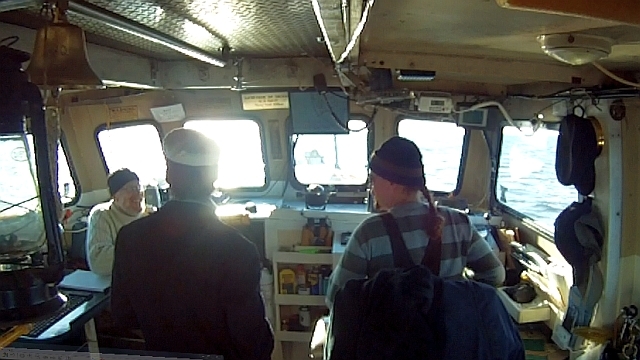
The wheelhouse on Roper. L-R is Dave Howe, Brian McNamara, and Brendan Burke.
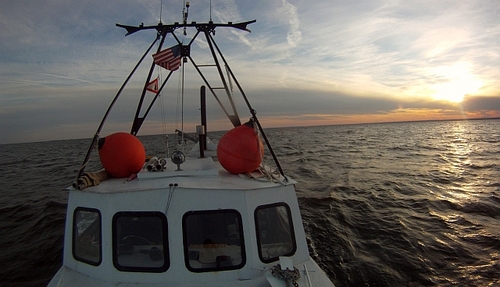
Little boat on a big bay.
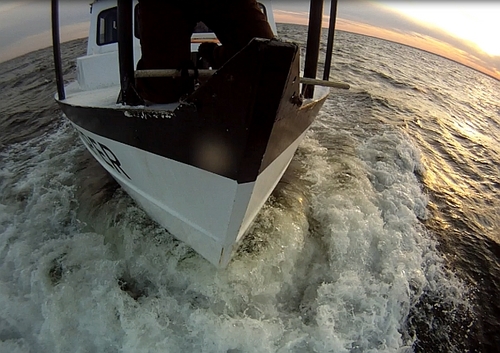
Plowing along, hour 9 out of 16.
The afternoon found us plowing up a smooth bay, a warm sun on the boat and sausage frying on the galley stove. The eternal pot of coffee was on its second charge of the day and Brian and I had been sharing the helm port/starboard style. Our only company was a tugboat pushing a barge, similarly upbound, and a few fishermen out of Tilghman Island bringing in the catch of their purse seines. The boat was quiet but life good. At night, life aboard takes on a different tone. Voices a little quieter, darkened nav screens provide the only light and eyes are constantly peeled to scan for other traffic. The nearer to Baltimore we steamed, the more and more traffic we encountered. Several channels fan out from Baltimore’s busy harbor and bay traffic is focused through a central channel conveying ships safely under the Chesapeake Bay Bridge. Tugboats pushing and towing barges plod back and forth, ships anchored waiting for berthing dot the southern approach to the bay bridge, and underway ships charging up and down the channel keep the helmsman plenty busy. It was a great experience for Brian and myself to practice and bone-up on our light signals from Navigation Rules, you don’t get to see much industrial traffic in St. Augustine. From pushing barges, to towed rigs, dredges, fishing boats, and cargo ships we got to see a bunch more than a routine evening in our own local waters.
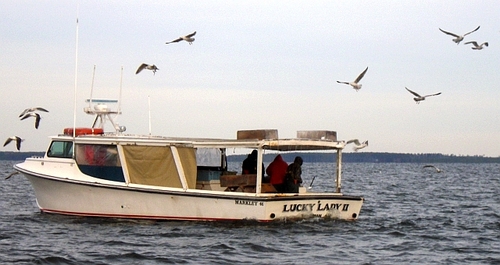
Fishermen on the bay.
Entering the Patapsco River, the main waterway connecting Baltimore to the bay, we encountered a snow squall. A southwestern breeze had sprung up and brought a quick, but heavy snowfall. A light patter of wet snow blanketed Roper’s foredeck and I lit the spotlight a couple times for a little while just to illuminate the dazzling tumult of brilliant flakes. Soon enough though, anticipation grew palpable as the final set of range lights at the bifurcation to the inner harbor hove into view. Leaving Ft. Carol to starboard, passing under the Key Bridge, and saluting the USNS Comfort (a Navy hospital ship), we finally made the turn at Ft. McHenry right about where Francis Scott Key penned the words to “The Defense of Ft. McHenry” now the words to our national anthem. Reducing engine rpms, we ghosted into the inner harbor roadstead towards our berthing at the Inner Harbor East Marina. At 1112 we backed into slip A35 and penned “Finished with engine” into the deck log. Met by friends from the conference, we offloaded and Brian and I headed to the Marriott to settle in.
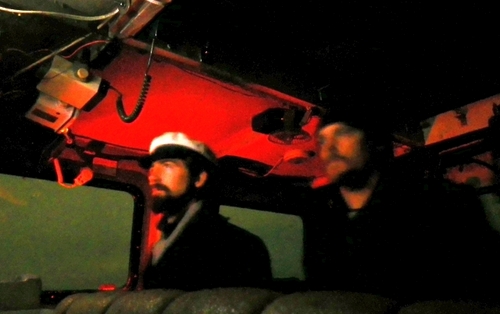
Night watch on Roper.
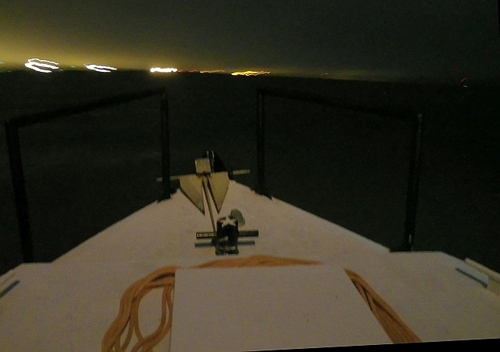
Arriving at the Patapsco River, right as it began to snow.
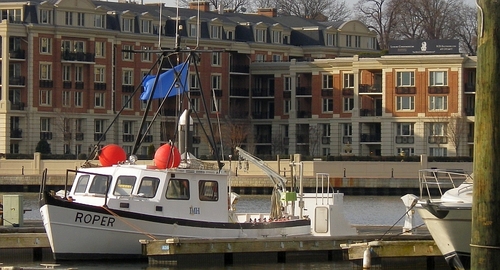
Berthed in downtown Baltimore.
For the next three days our lives were a mixture of paper sessions, impromptu meetings with old colleagues, and a little sightseeing along Baltimore’s historic waterfront. The LAMP session was not until Friday afternoon and so I took Thursday afternoon to visit the USS Constellation, an 1850s warship built to combat the slave trade ( a ship the Jefferson Davis, in her former life as the Echo, would have hated to encounter). We toured through all of her decks and, despite this being my second time aboard, I was continually impressed at the scale and magnitude of men and machinery needed to keep this man-o-war alive and fighting. Like many of her fellow historic ships, the hardest fight now is to remain afloat and in proper condition. Throughout the nation and world ships that have conquered great enemies, fought bravely in famous battles, or delivered explorers to the farthest reaches of our watery universe now languish under peeling paint and cakes of rust. I encourage you all to visit museum ships (and museums!) wherever you go, the value of your experience aboard them far outweighs the small cost of entry.
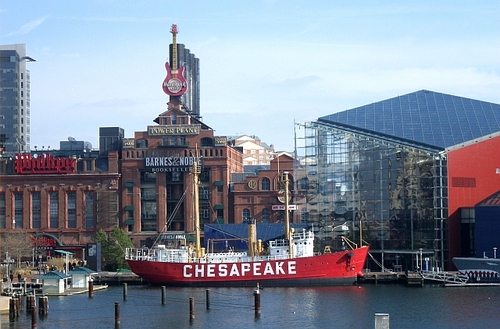
Baltimore’s beautiful Inner Harbor. Note the lighthship Chesapeake.
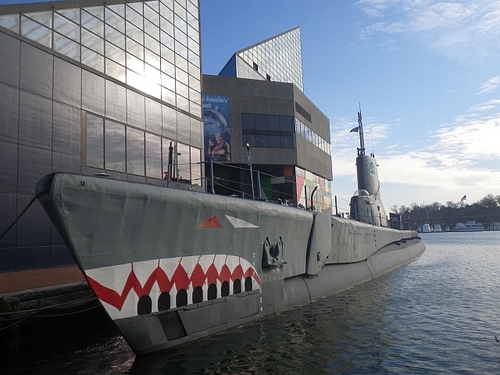
The USS Torsk, the last US naval vessel to sink a Japanese ship during WWII.
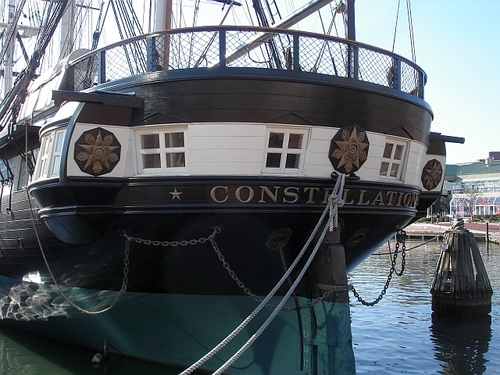
Stern view of the USS Constellation.
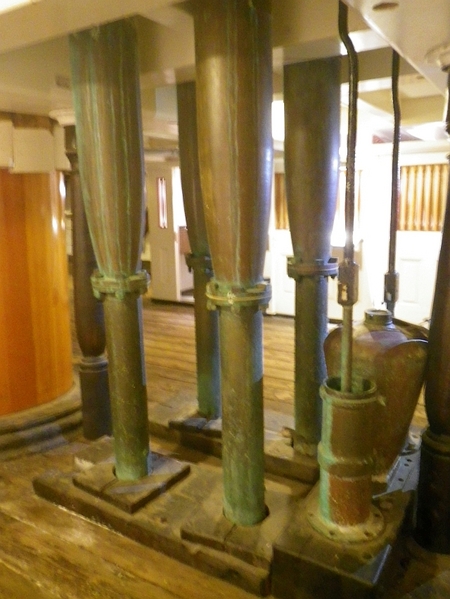
The pumps of the Constellation, not terribly unlike the lead pump found on the Storm Wreck Site.
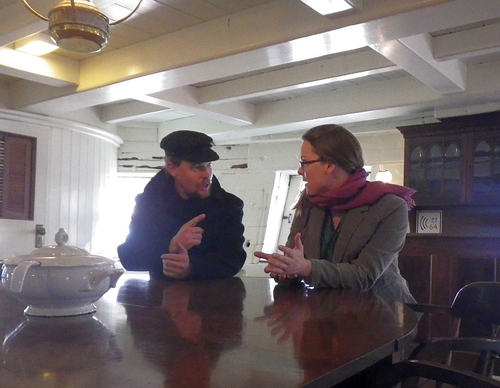
Brendan Burke and Kathy Lowe, archaeologist for Historic Colchester, Fairfax, Virginia having a discussion at the wardroom of the USS Constellation.
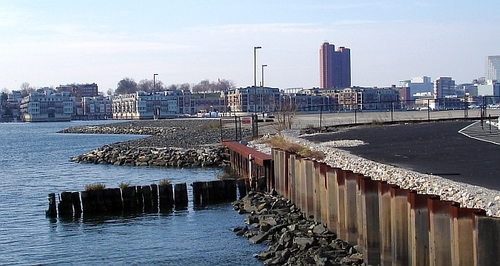
Much less bustling than during 1845, but the location at Fell’s Point where the Jefferson Davis was built. Click HERE to learn more about this infamous ship!
Four different times during the conference Roper shifted over to the water taxi dock at the Marriott to take on passengers for harbor cruises. On Thursday evening a group of 15 Florida State alumnus joined us and, after touring the inner harbor, we dropped them off at the dock by the Constellation. When I was turning Roper in the space between the tallship and the dock, I was suddenly struck by something. The view from all of the pilothouse windows was nothing but the black and white checked stripe of the Constellation’s hull. Her gunports open, the visual broadside was deadly beautiful.
I had an opportunity to visit the B&O Railroad Museum that evening after docking the boat. We were bussed over to the museum for an SHA sponsored gala. The giant roundhouse was still decorated for the holidays and houses a magnificent collection of railroadiana. Steam engines from the early 19th century, and on, bedeck the outer rim of the roundhouse and the turntable was the center of the event. A great bluegrass band played for us as we caught up on the past year’s work and explored the museum’s collection.
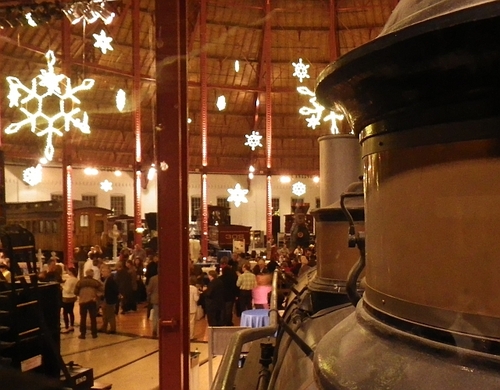
The evening gala at the B&O Museum, what a beautiful place!
Friday afternoon’s session was packed. From 1:00 until 3:30 the room was filled with colleagues (standing room only) as Chuck, Dr. Sam, Starr, Brian McNamara, Matt Hanks, and I presented our research. The session discussant was John deBry, a fellow scholar of early American maritime history. At the bottom of the page, I have included the session abstract and paper titles. Later during the conference, we were approached by numerous individuals interested in our work and received more and a few compliments on our presentations. A gentleman from Versailles, Kentucky, Mr. Rod Hatt attended our session. He owns a company that we have been working with to analyze coal from shipwrecks. As some of you readers may remember from our 2007-2009 field seasons we recovered a large amount of coal from the steamship/ballast pile wreck we were working on. Mr. Hatt will burn the coal in a machine that can analyze it as a sample and, we believe, learn about where the coal originated. From that, we may learn more about where the ship was picking up fuel, or perhaps cargo. We had not met before, so it was a pleasure to have him follow us to Baltimore to hear more about our research. Stay tuned on that front as we hope to learn much about coal petrography, volatile and combustive natures and other facets of obscure but interesting science that help us make discoveries.
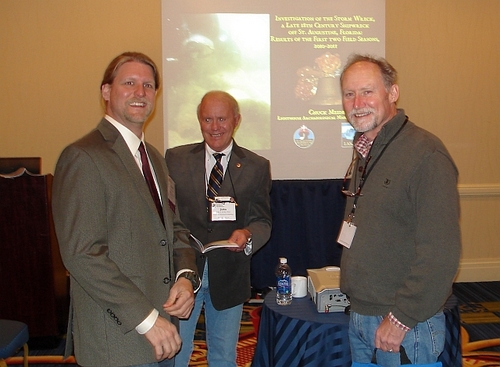
LAMP’s Chuck Meide discussing with John deBry, session discussant, and Dr. John Bratten of the University of West Florida before the LAMP session.
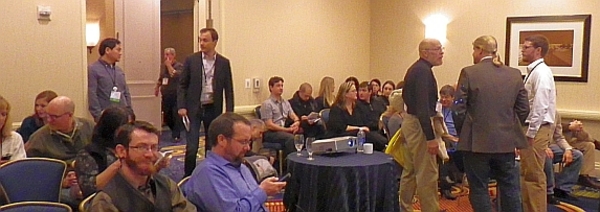
The crowd assembling as the session prepares to get underway.
By Sunday, we were all ready to depart. Brian and I drove back to St. Augustine by automobile as our positions on Roper were filled by friends. Our drive was the same length as the boat’s and only minutes after she pulled back into her berth at Tall Timbers, I was similarly moored at home, seven hundred miles to the south. SHA Baltimore 2012 was a great conference. We were able to get out the good word about our past two field seasons and go into a bit of depth about the wreck we’re currently working with. Conferences are also a great place to bounce ideas and thoughts off colleagues. What could be cursorily passed off as simple ‘good times’ is actually much more rewarding. A substantial portion of the world’s maritime archaeologists attend the conference and we are able to directly interact in formal, and less formal, situations to move our research forward and strengthen the field. Many thanks to everyone who helped make SHA possible, especially to the St. Augustine Lighthouse & Museum, the Institute for Maritime History and David Howe (owner of Roper). Stay tuned as we are working on publishing the proceedings of the conference and will have those, along with the published proceedings from the LAMP session during the 2010 SHA available here at the St. Augustine Lighthouse & Museum!
Sponsored Symposium: Investigation of the Storm Wreck, a Late 18th
Century Shipwreck Off the Coast of St. Augustine, Florida: Results of the
First Two Excavation Seasons, 2010-2011 [SYM-251]
Sponsor: Lighthouse Archaeological Maritime Program
Organizers/Chairs: Chuck Meide
In 2009, Lighthouse Archaeological Maritime Program (LAMP) archaeologists
discovered the buried remains of a colonial-era shipwreck while testing a
magnetic target near St. Augustine’s relict 18th century inlet. Systematic
excavations were conducted in the summers of 2010 and 2011, in conjunction
with LAMP’s annual field school and carried out from RV Roper on loan from the Institute of Maritime History. Despite particularly challenging diving
conditions of poor visibility and strong surge, sixteen square meters of the site
have been fully or partially excavated to date, revealing a wide array of ship
fittings and equipment, armament, cargo items, and personal possessions. Most
artifacts encountered, including the ship’s bell and two out of six cannons, have
been recovered for analysis and conservation in LAMP’s laboratory facilities.
This symposium will overview the methodology used for excavation and data
recovery and the preliminary findings of ongoing analyses of recovered material
culture.
Papers (in order of presentation)strong>
Meide, Chuck (Lighthouse Archaeological Maritime Program, United States)
Investigation of the Storm Wreck, a Late 18th Century Shipwreck Off the
Coast of St. Augustine, Florida: Results of the First Two Excavation
Seasons, 2010-2011
In 2009 Lighthouse Archaeological Maritime Program (LAMP) archaeologists
discovered the buried remains of a colonial-era shipwreck (8SJ5459) while
testing a magnetic target near St. Augustine’s relict 18th century inlet. Systematic
excavations were conducted in the summers of 2010 and 2011, in conjunction
with LAMP’s annual field school and carried out from RV Roper on loan from
the Institute of Maritime History. Despite particularly challenging diving
conditions of poor visibility and strong surge, sixteen square meters of the site
have been fully or partially excavated to date, revealing a wide array of ship
fittings and equipment, armament, cargo items, and personal possessions. Most
artifacts encountered, including the ship’s bell and two out of six cannons, have
been recovered for analysis and conservation in LAMP’s laboratory facilities.
This paper will overview the methodology used for excavation and data recovery
and the preliminary findings of ongoing analyses of recovered material culture.
Burke, Patrick B (Lighthouse Archaeological Maritime Program, United States),
David Howe, Matthew Hanks, Mike Jasper
Davit and Goliath: Landing Big Fish on Light Tackle
Recovering heavy artifacts from within the seabed is not something
archaeologists do on a daily basis. This paper documents the raising of two
cannons from the Storm Wreck site during the 2011 LAMP field season and the
logistics involved in this process. While heavy artifact recovery has certainly
been accomplished throughout the field, this recovery eschewed traditional lifting
devices such as barges, cranes, or other commercial lifting gear. Instead, an
apparatus and recovery method was designed that provided an in-house lifting
capability aboard the project dive vessel, allowing the archaeological team
flexibility in recovery technique, timing of the operation, and tools used.
Equipment was limited to commonly-available components in order to minimize
cost and increase flexibility in the use of the apparatus. Field testing of recovery
gear, safe working load limits of components, and the engineering premises for
lifting tackle are discussed here to highlight this specific platform as a template
for applications elsewhere.
Turner, Samuel P. (LAMP, United States)
Artillery of the Storm Wreck
After the close of the first excavation season, a number of cannon were
discovered in December 2010 during a routine monitoring dive on the site of the
late 18th century Storm Wreck off the coast of St. Augustine in St. Johns County,
Florida. LAMP’s 2011 excavation season focused on this newly exposed area,
resulting in the identification of six cannon which appear to represent three
distinct gun types, including both carronade-style ordnance and traditional long
guns. The guns were recorded and two representative pieces raised for detailed
study, conservation, and eventual display. This artillery is useful as a dating tool
for the site and can possibly yield clues as to the nationality of the shipwreck.
This paper addresses the latest analysis of this artillery.
Bell, Sam (LAMP, United States), presented by Brian McNamara
Cooking with Fire: What Cookware and Tableware Can Tell Us About an
Unidentified 18th Century ShipwreckDuring the summer months of 2010-2011, the Lighthouse Archaeological
Maritime Program (LAMP) conducted excavations at the Storm Wreck
(8SJ5459), an unknown 18th century shipwreck located offshore St. Augustine,
Florida. Two areas of the buried shipwreck were partially excavated within 19
one meter by one meter excavation units. A variety of artifacts were recovered
from the excavation units, including an assortment of cookware and tableware.
This paper will discuss artifacts relating to cookware and tableware and present
preliminary research regarding these items and what they can inform us about the
ship, its passengers, and the colonial residents of St. Augustine. As the name of
this ship remains a mystery, this paper will investigate the diagnostic features of
the artifacts and any relation they may have in the identification of the shipwreck.
Hanks, Matthew (Lighthouse Archaeological Maritime Program, United States)
The Storm Wreck Concretions: A Look Beneath the Surface
Concretions, one of the more mysterious features common to shipwreck sites, are
amorphous conglomerates of artifacts formed by the corrosion of ferrous metals
in an underwater environment. During summer fieldwork conducted in 2010 and
2011, LAMP has recovered over 40 concretions from the late 18th century Storm
Wreck site off the coast of St. Augustine, Florida. Utilizing medical technologies
such as x-ray, magnetic resonance imaging (MRI), and computerized axial
tomography (CT scan) it is possible to obtain a sneak peek of the contents of the
concretions. Thus far, concealed ship fasteners, cargo items, tableware,
armaments, personal possessions, and other equipment have been identified by
this method. These images provide conservators with a roadmap of sorts to guide
in the removal of the artifacts from corrosion byproducts. This paper will present
a number of concretions recovered from the Storm Wreck, their medical imagery,
and conservation status.
Cox, Starr N. (Lighthouse Archaeological Maritime Program (LAMP), United
States)
Personal Items Recovered from the Storm Wreck, a Late 18th Century
Shipwreck off the Coast of St. Augustine, FloridaIn 2009 a Lighthouse Archaeological Maritime Program (LAMP) survey located
a shipwreck tentatively dated to the late 18th century by material culture
subsequently recovered from the site. During the course of the 2010 and 2011
field seasons sixteen square meters of the buried site was excavated, and a
quantity of material was recorded in situ before removal for conservation and
analysis. This paper examines the category of personal items recovered as either
solitary objects or within concretions, some of which may prove to yield clues as
to the date, nature, and purpose of this vessel’s final voyage.

